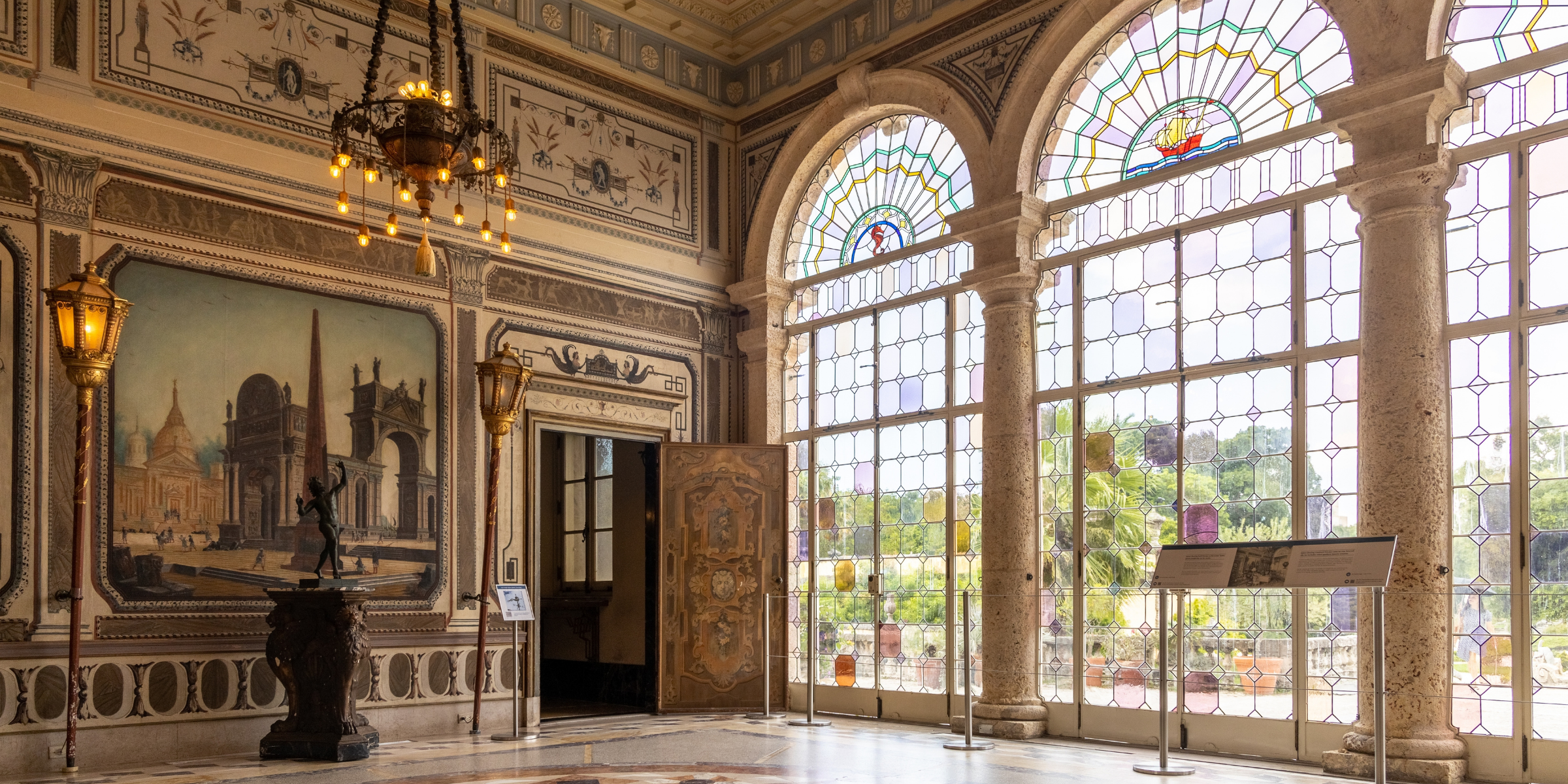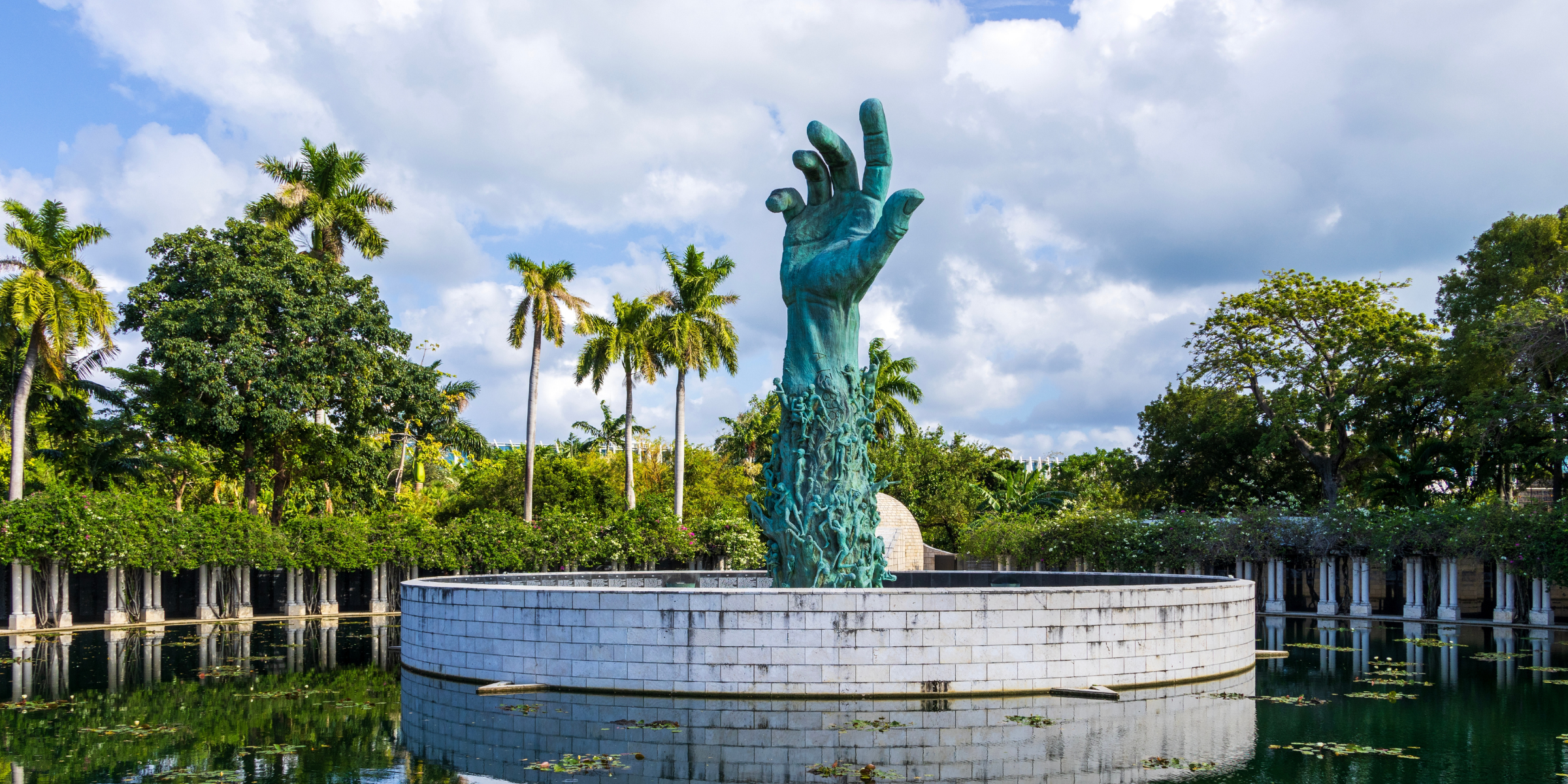The Jewish Traveler
Miami Reinvents Itself—Again

As we strolled down Collins Avenue in Miami Beach, my daughter and I marveled at the royal palms and the high-rise resorts shimmering brilliantly against an impossibly blue sky. My mother gazed upward, too, but I could tell she was seeing something else entirely.
“I remember the year my parents and I vacationed at the Eden Roc. I was about 13,” she said, referring to the 1950s-era oceanfront resort, a landmark designed by famed Jewish architect Morris Lapidus that is still in business. “One morning, I drank what I thought was orange juice at the brunch buffet—and got really sick.” It turned out to be a screwdriver.
As we walked, salsa music wafted from passing cars, mingling with snippets of conversations in German, Russian, Spanish and Brazilian Portuguese. It was a distinctly modern soundtrack, the latest iteration of a beguiling and ever-shifting cultural mélange that has long been Miami’s calling card. (Miami Beach is the barrier island across Biscayne Bay from downtown and technically a separate city within the larger Miami-Dade County.).
Like every great metropolis, Miami is continually reinventing itself, but lately, the pace of that evolution has accelerated to a frenzy. I’ve been visiting South Florida all my life, and I have never witnessed the kind of energy I’ve seen in the past decade: an explosion of building, population and affluence that has the feel of a modern-day gold rush. Entire skyscraper neighborhoods in Brickell and Edgewater have sprouted practically overnight; other neighborhoods have gentrified at a dizzying rate; and prices for everything from condos to croissants have soared sky-high. It’s a spirit familiar from the Marx Brothers’ The Cocoanuts, a 1929 caper that sends up, among other things, the entrepreneurial ethos fueling Miami’s Art Deco-era boom.
Jews have played an outsized role in Miami’s economy and civic and cultural life since the city was founded. According to a 2024 population survey from the Greater Miami Jewish Federation, Miami-Dade County boasts more than 130,000 Jews—around 5 percent of the total population (though the proportion is several times higher in some neighborhoods like Surfside and the suburb of Aventura).
Miami also stands out for the way Jewish heritage is ubiquitous and woven into the landscape, and not siloed in Jewish institutions, historic districts or memorials, though there are plenty of those as well.

In Miami Beach, for instance, it’s hard to find a block without an evident Jewish imprint. Along the Collins Avenue oceanfront, the Eden Roc stands near another Lapidus-designed hotel, the Fontainebleau, each with a 21st-century facelift. Seemingly around every corner from these and other hotels stand a yeshiva, kosher pizzeria or street named for a Jewish icon—like Isaac Bashevis Singer Boulevard in North Beach, the now very Argentinian district where the great writer once lived.
Jews were permitted to settle in Florida in 1763, when the Spanish ceded the colony to Great Britain in exchange for Cuba. But Miami remained a literal and metaphorical backwater until more than a century later. Its first Jewish community coalesced in the 1890s, when Eastern European immigrants migrated south from New York and, by 1896, owned 12 of Miami’s 16 fledgling businesses.
Isidor Cohen, a retail pioneer considered the father of Miami Jewry, was among the 400 some men who voted to incorporate the city in 1896. Known for his civic leadership and inclusive relations with Miami’s Black community, Cohen recently was honored by having a portion of Southwest Second Street named for him.
The Jewish population mushroomed along with the city, reaching nearly 4,000 in the 1920s, when automobiles and airplanes put the tropics in reach of winter-weary Northerners. During those scrappy prewar decades, Jews flocked to the opportunity offered by boom-and-bust business and tourism cycles—despite restrictions on Jewish ownership and occupancy that only lifted in the late 1940s.
Enthralled by the sunshine and a frontier culture, Miami’s Jews were prominently involved in founding not only the city’s enduring hospitality sector but also its retail scene, its universities—including the University of Miami in Coral Gables—and its civic institutions and elected offices. Miami Beach, for instance, has had 15 Jewish mayors.

There are close to 5,000 Hadassah members, associates and donors in Hadassah Greater Miami, a region that includes Puerto Rico, the Keys and Miami-Dade County. It is one of four regions that make up Hadassah Florida. Statewide, there are over 45,000 Hadassah members.
Over recent decades, Jews have maintained a steady migration from colder climes to settle suburbs like Aventura, where Hadassah will be holding its National Conference from August 10 to 12. Earlier, in the 1970s and 1980s, retirement communities sprouted along the so-called Gold Coast from Miami north to West Palm Beach.
But anyone who still thinks of South Florida as a retirement mecca hasn’t been paying attention. Greater Miami feels younger, less seasonal and more diverse than in years past thanks to the nation’s largest net international migration rate. Newcomers are arriving from virtually every corner of South America as well as Canada, Israel and Eastern Europe. The Israeli influx is driven largely by the appeal of Florida for entrepreneurship—and its proximity to both North and South American markets—with roughly 430 Israeli-founded companies in the state, most in the Miami vicinity.
All these forces have contributed to a metro population that grew at more than twice the national rate last year, with an average of 155 people arriving each day. Miami’s Jewish numbers grew by 9 percent over the past decade, with the proportion of children increasing at twice the rate of older people.
As a result, Miami has a notable cosmopolitanism that is evident in everything from the splashy annual Art Basel show and Miami Book Fair to tech bros paying for empanadas with crypto. Downtown in particular has matured from a rather sterile, featureless district into a bustling high-rise neighborhood alongside the revitalized Bayfront Park.
One thing that hasn’t changed is the ubiquity of Spanish as Miami’s lingua franca, rather than a minority tongue confined to ethnic enclaves. While “Hispanic” in Miami was once synonymous with “Cuban”—the city remains ground zero for that country’s politically exiled diaspora—now it could mean anything from Puerto Rican to Mexican to Argentinian.

Kosher areperías (bakeries specializing in arepas, Caribbean-rim corn patties) speak to the burgeoning presence of Jews who have escaped here from troubled Venezuela, while Argentina’s inflation-plagued economy has prompted thousands of its residents, many Jewish, to settle in neighborhoods like North Miami Beach’s “Little Buenos Aires.”
A few years ago, I met members of the Plutzik family—father Jonathan, a financier and philanthropist, and son Zach—at their then-newish Ocean Drive hotel, The Betsy. Like generations of Ashkenazi Jews before them, the Plutziks saw opportunity—in this case, an aging Georgian colonial mansion—and opened the latest Jewish-owned hotel. Partly out of passion, partly as a tribute to Jonathan’s late father, the noted poet Hyam Plutzik, The Betsy has become a South Beach cultural hub, hosting live events and writers-in-residence, including, in May, My Salinger Year author Joanna Rakoff, who also contributed an essay to the 2024 anthology On Being Jewish Now.
Indeed, Miami’s arts scene, long overshadowed by its beach culture, has evolved in ways that feel organic to a place where life is largely lived outdoors. At downtown’s Pérez Art Museum, for instance, I’ve often felt the modern art inside is rivaled by the stunning interplay of light, color and design in the sculptural courtyards and terraces that showcase views over Biscayne Bay.

On Miami Beach’s Lincoln Road, outdoor concerts and sculpture installations give the pedestrian thoroughfare the feel of an open-air gallery. Nearby, at the New World Center, warm nights bring picnicking crowds to an outdoor film series, dubbed “Wallcasts,” projected on the center’s facade. And in Wynwood, a formerly industrial district north of downtown, the aesthetic experience is immersive for those who stroll amid murals, painted sidewalks and colorfully rehabilitated buildings.
In spite of the heat, the hurricanes and the hype—all of them relentless—Miami retains a beguiling energy that few cities can match. It’s what drew my great-grandparents, Austrian-born New Yorkers, to settle here in the 1950s, the first of four generations to do so.
“There were ambulances outside the nightclubs, waiting to cart off the retirees who collapsed on the dance floor,” recalled my mom in what may well be an apocryphal memory of my great-grandfather’s passing. “My grandfather always said he wanted to die dancing. And in Miami Beach, he did.”
Many Miami visitors never make it north of South Beach, the fabled neighborhood of Art Deco and nightlife at the southern tip of Miami Beach, which is itself bounded by the Atlantic Ocean to the east and Biscayne Bay to the west and crisscrossed by major arteries. But neighborhoods like North Miami Beach, with its picturesque canals and peaceful beaches, and Surfside, a vibrant hub of Jewish life at the isle’s northern tip, are well worth the effort.
South Beach is among Miami’s most urbane districts, and likely its most historic. On Washington Avenue, the Byzantine-Moorish facade of Temple Emanu-El, a circa-1940s landmark housing a 90-year-old congregation, stands catty-corner to the arresting Soundscape Park and New World Center, a sculpture garden and arts complex designed by the Jewish architect Frank Gehry.
Washington Avenue is also home to two prominent museums with Jewish pedigrees, both operated by Florida International University. The Wolfsonian-FIU, a modern art venue, was founded by the late Mitchell Wolfson Jr., a Miami-born businessman and art collector whose father was Miami Beach’s first Jewish mayor.
A block inland from Ocean Drive’s lively restaurant strip is the Jewish Museum of Florida-FIU, showcasing more than 250 years of Jewish life in the Sunshine State. The museum is housed in two bright yellow Art Deco buildings built for the now-defunct Congregation Beth Jacob, a relic of the era when Jews were legally restricted to this southern stretch of South Beach.
Lincoln Road is the neighborhood’s pedestrian heart. It is an eight-block strip of outdoor cafes and chain stores whose enchantment owes largely to Morris Lapidus’s midcentury sculptural flourishes, lavish fountains and shady botanical plantings. Lapidus, the Odessa-born designer, was the Jewish visionary behind such enduring Miami Beach landmarks as the Eden Roc and Fontainebleau hotels and Temple Menorah on 75th Street.

It’s impossible to miss Miami Beach’s Holocaust Memorial, which was dedicated by Elie Wiesel in 1990 on a busy corner of Dade Boulevard. Kenneth Treister’s unnerving sculpture features a 40-foot-tall hand reaching toward the sky from its base in a lily pond; tiny human figures clamber upward from the base of the tattooed forearm.
For my money, an indelible sight is the expanse of sea and sky visible from the causeways across Biscayne Bay. And while the sprawl of Miami proper can be disorienting, several distinctive neighborhoods are worth crossing the bay for those with a car. These include Coconut Grove, the upscale, waterside district with a vibrant cafe and bookstore scene. A major attraction here is the circa-1916 Vizcaya, an Italianate mansion with formal gardens that was built as the winter home of corporate titan James Deering.

Further north is Wynwood, a former industrial district transformed by murals, art galleries and destination eateries, including Zak the Baker, a kosher-certified bread and dessert emporium owned by Zak Stern. Lovers of Cuban culture head west to Little Havana, a fabled neighborhood that can feel disconcertingly sleepy from the sidewalk, but inside Castro-era haunts like Versailles, the café con leche and dominoes scene are both legendary.
Greater Miami has such an abundance of kosher options that it is impossible to list them all. Consult a website such as Yeah That’s Kosher before your trip.
Hilary Danailova writes about travel, culture, politics and lifestyle.











 Facebook
Facebook Instagram
Instagram Twitter
Twitter
Claudia Piranio says
Please correct the names of the streets in Miami Beach. As a local, visitors should know the right name. It’s Washington Avenue and Ocean Drive. If people look for Ocean Avenue they won’t find it.
Alan Mishael says
Very nice review. Thank you.
Charlotte Tomic says
Fabulous article about the flavors and beauty of Miami Beach! Thank you!